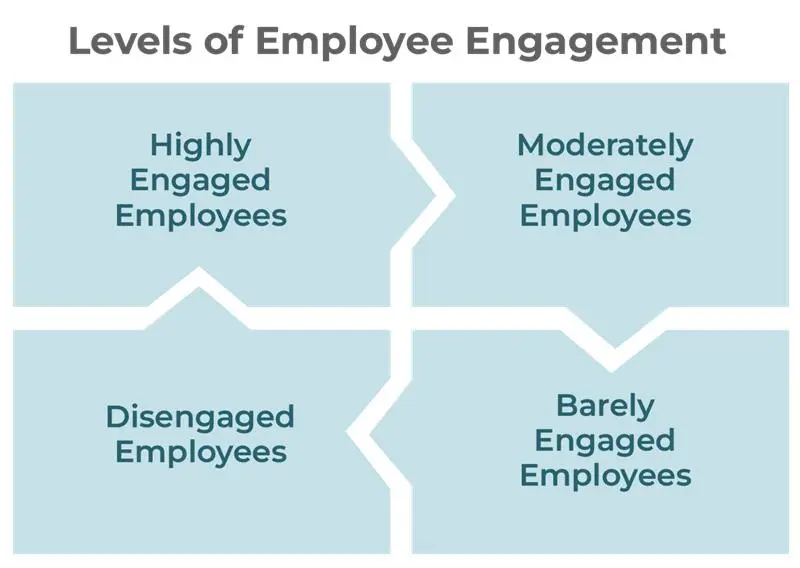When HRs start discussing employee engagement, employees often believe they are trying to come up with some fun games to spruce up the office. However, the reality is that employee engagement is far more relevant for the overall functioning of a company than office games and recreation.
A 2023 survey by Gallup found that only 32.48% of Indian employees are engaged at their workplace, while 19.37% of them remain actively disengaged. This statistic paints a bleak picture of Indian workplaces, where employee engagement is often relegated to be an afterthought.
So, what is employee engagement and what are its benefits? Why is it so relevant to the organization? And what are some of the best strategies to improve employee engagement?
Let us find out!
What is Employee Engagement?
Employee Engagement is the concept that helps us understand the relationship between an employee and their employer. It defines the dedication and enthusiasm an employee feels while undertaking their responsibilities in their workplace.
To answer the question ‘what is employee engagement’, we need to understand who an engaged employee is. An engaged employee is one who is actively involved with their company and is personally invested in accomplishing their tasks. As a result, companies with high employee engagement rate are bound to outperform an organization with disengaged employees. Hence, employee engagement is extremely important to businesses looking to improve their output and profits.
Employees who are actively engaged with their businesses often display improved productivity, increased trust and loyalty, reduced absenteeism, and stay longer in their organizations. All these factors enable the company to improve its employee experience using an employee management system, which results in improved client and customer satisfaction, enhanced company culture, and a better employer brand.
Hence, organizations have been investing in employee engagement initiatives, and the HR department is tasked with strategizing these initiatives and ensuring that everyone is on board. With the rise of remote and hybrid working, employee engagement strategy has varied a lot in recent years. However, the basic idea behind these strategies is to keep the staff members motivated and satisfied, ensuring employee engagement.
Employee Engagement Examples
Here are a few employee engagement examples from renowned companies which will provide you with a good idea of simple yet effective engagement strategies, that will improve your company’s engagement rate by multiple times:
1. Dreamworks
Being an animation studio, Dreamworks Animation encourages creativity by letting its employees show off their personal artwork by organizing parties after the completion of big projects. They also offer paid opportunities to spruce up their workplace, further maintaining the flow of creativity. By encouraging such activities, their employees are honing their skills without formal training, encouraging an informal flow of talent.
2. GitHub
GitHub provides unconscious bias training sessions, mentorship programs, privilege awareness training, etc. to encourage their employees to actively participate in their company’s DEI initiatives. Additionally, they also set their leadership to track goals related to DEI, to ensure equitable opportunities to everyone within the organization.
3. Starbucks
Starbucks supports its employees’ education opportunities and has other employee-friendly practices in place to gather employee engagement. They also provide their employees with ‘Bean Stock’, which are company stocks given to their employees after a certain level of experience in their organization. Such strategies provide their employees with value, which translates to increased employee engagement.
4. Hyatt
Hyatt treats their employees with respect and empathy as they believe the same treatment will be transferred to their customers. They also permit their employees to remain true to themselves while interacting with their guests, which provides their guests with a better experience. Such strategies help the staff to identify with their company and stay engaged for longer.
5. The Cheesecake Factory
The Cheesecake Factory prioritizes employee training and recognition to ensure that they remain skilled and satisfied with their workplace. Similarly, they have a ‘Wow Stories Initiative’, which shares motivational stories recognizing the staff within the company, resulting in increased motivation in the organization.
Levels of Employee Engagement
Depending on how engaged employees are with their organizations, we can define several levels of employee engagement. These employee engagement levels not only indicate how engaged the employees are with their companies, but also reveal how much they are satisfied with their organizations and is reflected in their daily undertakings.
The different levels of employee engagement are:

➔ Highly Engaged Employees
Highly engaged employees are the promoters of the organization. They have a very positive outlook of their company and are always working towards the betterment of their organization. They understand that their company is interested in their career growth, and hence, motivate others too. As a result, employers wish to have more highly engaged employees in their organizations.
➔ Moderately Engaged Employees
Moderately engaged employees are also engaging with their companies, although not up to the extent they would have been. Some or the other reasons hold them back from fully committing themselves towards their organization. While these employees are engaged with their company, they may not ask for additional responsibilities or even underperform in their work.
➔ Barely Engaged Employees
Barely engaged employees are indifferent towards their workplace as they do not find it engaging enough. Hence, they lack the motivation to fully commit towards their work and are often found doing the bare minimum. They may even be thinking of enquiring about the full and final settlement process and switching jobs or would be even actively looking for better opportunities.
➔ Disengaged Employees
Disengaged employees despise their workplace and are disassociated from their company mentally. They do not have any concern for the company’s future and lack any sense of responsibility towards their role and its duties. They also harbour negative sentiments towards their company and may try to detract others from undertaking their duties.
Types of Employee Engagement
There are 3 main types of employee engagement:
1. Emotional Engagement
Emotional engagement is the emotional connection the employee feels towards their organization. If they are happy with their company and trust their company to fulfil their needs to undertake their work to the best of their abilities, employees would be engaged emotionally with their companies.
2. Physical Engagement
Physical engagement is the physical and mental effort the employee puts in to undertake their work to the best of their capabilities. They make it a personal initiative to accomplish their goals and are ready to even put in extra hours to complete their tasks if required. Such kind of engagement often requires extra effort, and the employee will willingly commit themselves towards their work if they are physically engaged with their company.
3. Cognitive Engagement
Cognitive engagement occurs when the employee feels a connection with the company’s mission and vision. They realize that their work is making a difference in the world, which helps them dedicate themselves to the company’s cause. An employee’s cognitive engagement happens when they commit themselves towards their company’s mission, ensuring complete dedication and work satisfaction.
Why is Employee Engagement Important?
Considering the different levels of engagement observed in an organization along with the numerous benefits associated with having highly engaged staff members, we can deduce that employee engagement is critical for the success of any organization. However, the importance of employee engagement is not only limited to the financial benefits associated with it.
Some of the other factors that make employee engagement important for companies are:
- Increased motivation
- Better quality of products and services
- Improved client and customer satisfaction
- Increased profits
- Enhanced employer brand
- Better talent attraction & retention
- Reduced absenteeism
- Better work culture.
Benefits of Employee Engagement
Now that we have a robust understanding of the importance of employee engagement for the organization, let us check out some of the major benefits of having engaged staff in the company. These benefits are the reason HR teams spend their valuable productive time and efforts in crafting creative and effective employee engagement initiatives.
So, let us understand these numerous benefits of employee engagement:
➔ Improved Productivity
A major benefit of employee engagement is the increased productivity numbers. Since these employees are genuinely concerned about their company and its undertakings, they are more likely to work towards accomplishing their goals. They will also be more motivated to work harder and smarter to ensure the success of their projects, resulting in better products and services.
➔ Enhanced Company Culture
Additionally, due to the increased number of highly motivated and engaged staff members, the company culture will be improved noticeably. Since the employees understand that their company cares about their well-being and is promoting a better work-life balance, they are likely to contribute more towards their work, resulting in enhanced company culture.
➔ Reduced Turnover
Since the staff members have increased employee engagement with their organization, they are less likely to leave the company even when presented with a better opportunity as they find their current job to be more fulfilling. Hence, increased employee engagement also results in a better employee retention rate within the organization.
➔ Enhanced Client Satisfaction
Similarly, employees with higher employee engagement will provide better services to clients, which results in better client satisfaction. On the other hand, if you are manufacturing products for your customers, engaged employees will ensure that the quality of your products is impeccable since they care about the items they manufacture, resulting in better customer satisfaction.
➔ Better Employer Branding
Engaged employees also understand that their company takes care of their well-being. They realize their importance for their organization, as well as understand how their company is enabling them to improve their skills and careers. As a result, having engaged staff members results in better employer branding, resulting in better talent attraction too.
➔ Reduced Absenteeism
Engaged employees are also less likely to take leaves as they care about their jobs and love undertaking their daily tasks. As a result, they take fewer leaves by avoiding casual leaves and remaining absent only if there is no other option. Reduced absenteeism also results in better productivity figures resulting in on-time project completion and better overall results.
➔ Increased Loyalty
Moreover, staff members with higher employee engagement also display increased trust and loyalty towards their organization. Since they believe in their company’s values and vision, they fulfil their duties to the best of their abilities. The increased loyalty also results in an increased retention rate within the organization, resulting in experienced staff who can undertake their tasks well.
Top Drivers of Employee Engagement
Those were some of the benefits of employee engagement for the company. We can observe that these benefits not only provide the organization with financial benefits but also multiple tangible collateral benefits such as better employer branding and client satisfaction.
So, let us understand the top drivers of employee engagement in an organization:
1. Sense of Belonging
The most important factor affecting employee engagement is the sense of belonging to the company. HRs should inculcate a sense of ‘belonging’ which enhances the feeling of making a difference. It goes a long way in ensuring employee engagement as well as enabling them to genuinely care for the products and services they develop for the organization.
2. Good Leadership
Similarly, HRs should also take extra precautions while choosing leaders for their company since they hold a greater influence over the company culture. Since they also affect the motivation levels of their subordinates, the HRs must choose the leaders of the organization wisely as good leadership can be the single most decisive factor for employee engagement, and the company’s success.
3. Valuing Ideas
The employees should also realize that their ideas are valued within the organization. It will result in a constant flow of innovative and unique ideas, which can help the company grow and resolve any challenges. Hence, HR should also ensure that everyone in the organization is given adequate opportunities to put forth their ideas.
4. Challenging Work
Since employees are working for the company daily, their daily duties and responsibilities may start becoming monotonous after a few years, which can lead to boredom and lowered engagement. Hence, they should be allocated challenging and stimulating work, which ensures a change of pace and increased engagement.
5. Employee Recognition
Employee recognition is another major factor that affects employee engagement significantly. Employees who are recognized and rewarded for their excellent contributions are more likely to repeat their success. Similarly, rewarding the performers will also provide additional incentives for others to work harder, resulting in increased productivity and engagement.
6. Growth Opportunities
Once employees understand the various growth opportunities available in an organization, they will be eager to seize them to improve their skills. It enables them to grow professionally, which also translates to better packages and positions. As a result, it will improve their productivity, which also results in better engagement with their organization.
7. Ethical Culture
Companies following ethical business practices are preferred by employees who wish to identify themselves with their organization. Hence, it is critical to follow ethical considerations while undertaking any business as it not only ensures integrity but also reflects on the employees, helping them stay engaged with their organization.
8. The Right Tools
Similarly, having the right tools at their disposal enables the employees to undertake their tasks with enhanced efficiency, improving their productivity and employee experience. Both factors play a significant role in increasing their engagement with their organization. Hence, employers need to provide their staff with the best tools available to ensure employee engagement.
9. Wellbeing Initiatives
A company that takes care of its employees’ wellbeing will also have engaged employees since they understand that their company values them as ‘humans’ instead of simply ‘resources’. As a result, they would want to stay with their organization for longer, resulting in better retention rates. Hence, having robust well-being initiatives is a must-have for any organization that wishes to improve its employee engagement rate.
10. Flexibility
The recent global pandemic has changed the landscape of jobs, with more employees opting for increased flexibility in their work. The flexibility can be related to their job hours or job location; with many candidates seeking the increased flexibility of freelancing over full-time jobs. In this scenario, having additional job flexibility options will surely result in increased employee engagement within your organization.
7 Best Effective Employee Engagement Strategies
Since employee engagement is critical for the success of any organization, it is essential to understand the strategies utilized by HR personnel to actively engage the employees. While some of these may seem superfluous at first, each strategy enables you to move a step closer to a completely engaged staff.
So, here are a few effective tried and tested strategies for keeping your employees engaged:
➔ Reaffirm Core Values
The most important strategy is to reaffirm your core values among your employees. You should let them understand the relevance of your business and the solutions you are providing to the world.
It will help them appreciate your efforts as well as have pride in the work they are undertaking in your company, resulting in increased engagement.
➔ Engage Management
Another good strategy is to engage the leadership, who, in turn, will engage their team members effectively. An engaging leadership can work wonders for their staff members since they can be inspired by their manager’s work.
By focusing your efforts on middle management, you can effectively motivate the staff, leading to better results with less effort.
➔ Emphasize Feedback
Feedback is an essential component of the employee experience and hence, it is essential to ensure that they receive an adequate amount of it.
However, it is imperative to understand how to share feedback with your team; while some prefer formal feedback, others prefer a more natural informal way of feedback. Despite how it is administered, the employees should have a positive response to it, which will also improve their engagement.
➔ Optimize Onboarding
Similarly, onboarding is an excellent touchpoint for employee engagement since you can create a positive impact on the recruit by helping them understand the company culture.
With effective and engaging onboarding strategies, you will have an employee who will be eager to undertake their tasks well, while also being a promoter for the company.
➔ Offer Career Growth
Similarly, by offering career growth and development opportunities, you help the employees understand how much their organization values them.
By enabling employee growth, you are conveying a strong message that you value them enough to invest time and money in undertaking their upskilling, helping them stay engaged with their company.
➔ Recognize Performers
You should also recognize and reward the performers consistently. It will send a clear message that you are monitoring their performance, and their achievements will be rewarded.
Hence, it is essential to offer tangible rewards and recognize them publicly, which will motivate others to work harder too.
➔ Deploy Surveys
You can also deploy multiple kinds of surveys periodically to understand the engagement rate within your organization. Surveys like pulse surveys, new hire surveys, stay surveys, exit interviews, etc. provide you with a robust idea of what is the overall employee sentiment towards the organization.
Hence, you can make positive changes to ensure positive responses in these surveys, which will further improve employee engagement.
Models of Employee Engagement
Since employee engagement is critical to the overall success of the business, many strategic models have been developed throughout the industrial age, which tackle different factors related to employee engagement.
Since these models focus on separate aspects of engagement, it is essential to understand them if you are serious about improving the engagement rate in your company.
The most common models of employee engagement are:
1. Aon Hewitt’s Engagement Model
The Aon Hewitt’s Engagement Model provides 6 key engagement drivers, and 3 outcomes based on the success of these drivers:
➔ Drivers
- Brand: Reputation, brand or EVP, corporate responsibility.
- Leadership: Senior leadership, BU leadership.
- Performance: Career opportunities, learning and development, performance management, people management, rewards and recognition.
- The Basics: Benefits, job security, safety, work environment, work-life balance.
- The Work: Collaboration, empowerment or autonomy, work tasks.
- Company Practices: Communication, customer focus, diversity and inclusion, enabling infrastructure, talent and staffing.
➔ Outcomes
- Say: Speak positively about the organization to coworkers, potential employees, and customers.
- Stay: Have an intense sense of belonging and desire to be part of the organization.
- Strive: Are motivated and exert effort toward success in their job and for the company.
2. Maslow’s Engagement Model
Maslow’s Hierarchy of Needs is a concept in psychology that identifies a hierarchy of human needs that establishes their motivation levels in life. This hierarchy can be translated to a professional setting as the levels from the most basic are:
- Physiological
- Safety
- Belonging & Love
- Social Needs
- Self-actualization
- Transcendence
While an organization may not be able to ‘transcend’ the employee, they can take care of the physiological, safety, belonging, and social needs of their staff, resulting in increased engagement.
3. Kahn Model of Engagement
The Kahn’s Model of Employee Engagement suggests three principle dimensions for employee engagement:
- Physical
- Cognitive
- Emotional
Furthermore, this model also provides three physiological conditions for improving engagement:
- Meaningfulness: An employee needs to find their work meaningful enough to remain engaged with it.
- Safety: The employee should feel safe to express their ideas without negative repercussions.
- Availability: The employee should be physically and mentally capable to be able to undertake their duties well.
4. Deloitte Employee Engagement Model
The Deloitte Employee Engagement Model suggest 5 key factors that improve employee engagement:
- Positive Work Environment: Flexible work environment, humanistic workplace, culture of recognition, inclusive and diverse work environment.
- Meaningful Work: Autonomy, select to fit, small and empowered teams, time for slack.
- Hands-on Management: Clear and transparent goals, coaching, investment in management development, and modern performance management.
- Growth Opportunities: Training and support on the job, facilitated talent mobility, self-directed dynamic learning, high-impact learning culture.
- Trust in Leadership: Mission and purpose, continuous investment in people, transparency and honesty, inspiration.
Conclusion
So, that answers the question, ‘What is Employee engagement?’. It may be a concept as old as industrialization, however, we can still develop new employee engagement strategy to improve it in an organization. Since the human resources of the organization are ‘humans’ after all, one should take care that any initiatives implemented are undertaken with the right mindset, which will lead to its successful implementation and success.









